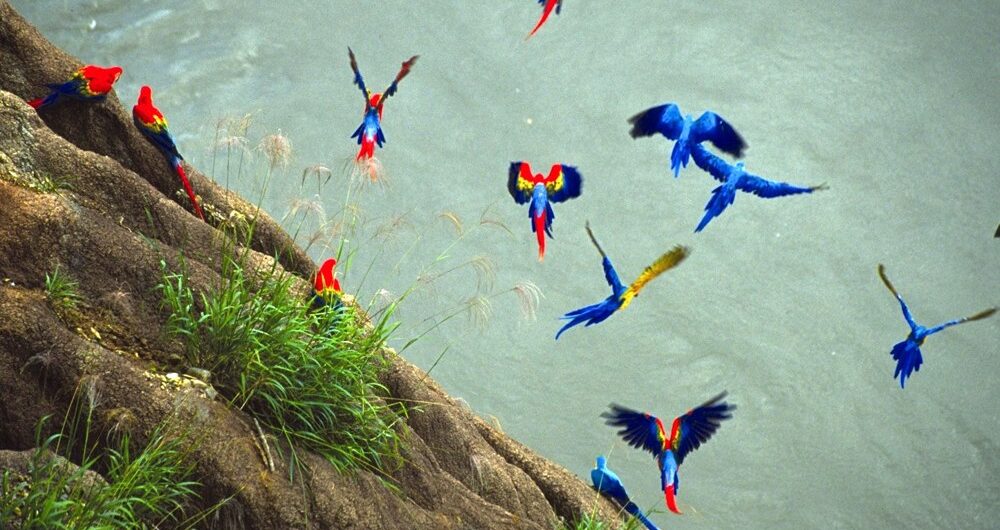A short boat ride from the Tambopata Research Center, a jungle lodge eight hours upriver from Puerto Maldonado, lies the largest known macaw clay-lick in the Amazon. On most mornings, hundreds of birds, including various species of macaws and parrots congregate at the clay, offering guests the unique opportunity to view this colorful spectacle and learn about the project through experiencing some of the daily activities of the lodge’s researchers. Recently, my colleague Simon and I were able to visit the research center and do just that.
Tambopata’s Macaw Project
Visiting the Clay Lick
We were awoken bright and early by our expert guide Yuri to visit the nearby claylick before sunrise, as we were informed this was the best time to visit just before the birds begin to arrive. Following our short boat trip to a small island across from the lick, we positioned ourselves on chairs and set up viewing scopes to watch from a distance, as to not disturb the birds and interrupt the research being conducted.
As the sun rose through the jungle canopy, birds began to slowly arrive, first hovering in the distance, before a group of brave souls decided the lick was safe from predators and approached the clay to begin their daily routine. Hundreds followed screeching and screaming, and we spent the next few hours on the island viewing the birds, taking photos, and spotting different species from our guide’s field map. Scarlet, Blue-and Yellow, Red-and-Green, Blue-headed, and Red-bellied to name a few of the types of macaws we had the opportunity to see. It was a true spectacle of the natural world and a dynamic sensory experience, the sounds and colors of this much birdlife assembling together.
Contact us to speak to an expert travel planner for information on visiting the Amazon
Learning About the Macaw Project
That evening, we were given a presentation about the Macaw Project from some of the on-site researchers and spoke with them, asking questions regarding the morning’s visit and the project in general. The Macaw Research Project began in 1989 in an effort to learn about the basic ecology and natural history of the beautiful birds and to use this information to to aid in their conservation. In conjunction with Texas A&M University, researchers monitor and observe the the clay lick, natural and artificial macaw nest sites, breeding patterns, feeding, movements, as well as conduct many other studies.
The following morning, another early knock on the bamboo walls of my room awoke me from my jungle slumber and with the guidance of some of the researchers from the previous night, we left to visit some of the nearby artificial nests to view examinations being conducted on newborn macaws, another fascinating insight into the research being done. Fortunately for us, one of the mothers had given birth less than 24 hours prior, and we had the opportunity to view the initial research and even hold the newborn!
The Experience at Tambopata Research Center
Overall, my trip to TRC and my experience with their Macaw Project was a once in a lifetime natural experience that I would highly suggest to anyone interested in visiting the Peruvian rainforest. Having visited other jungle lodges closer to Puerto Maldonado (and civilization) along the way, I think the extra hours upstream are certainly worth it. If my description and photos aren’t enough, check out this awesome, short documentary filmed at TRC about the Project for some more inspiration.
Contact us to include a visit to the Tambopata Research Center and the macaw clay-lick on a tailormade, luxury journey to Peru.

